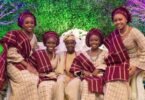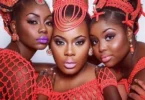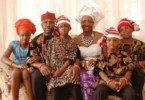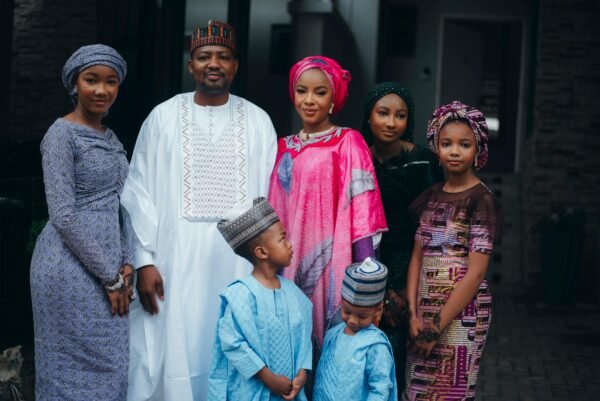
A Hausa, or more specifically, a West African group from Northern Nigeria, has a highly developed and classy fashion. In this article, we delve into analysing how Hausa fashion remains bound to traditions but is also in sync with the current trends in fashion; the fashion reflects Hausa’s cultural and religious inclinations with specially gifted skills in fashion designing. The traces of gorgeous traditional African fashion are everywhere, beginning with the costumes and ending with various ornaments and accessories with the distinctive features of the Hausa people.
Moreover, this article maps out the origin of Hausa fashion and, more especially, their features in today’s world fashion.
1. Historical Roots of Hausa Fashion
The fashion of the Hausa people dates back to the pre-colonial period when the Hausa Tele, was known for its elaborate trade in everything, including textiles and leather products. With the coming of Islam in the 11th century, the costumes of the Hausa became appreciably more modest, graceful, and refined.
Key Influences:
- Islamic Heritage: The Islamic cultural standard of dressing greatly influenced the Hausa people’s fashion to adopt clothing that covered nearly all of their skin and simple patterns.
- Trade Connections: When the trans-Saharan trade came into the region, new luxurious fabrics such as silk and brocade were imported, changing the fashion of the Hausa people.
- Local Craftsmanship: The intricate touches used by the Hausa people in terms of dyeing, weaving, and embroidering their clothes were ancient and original.
2. Traditional Hausa Attire for Men
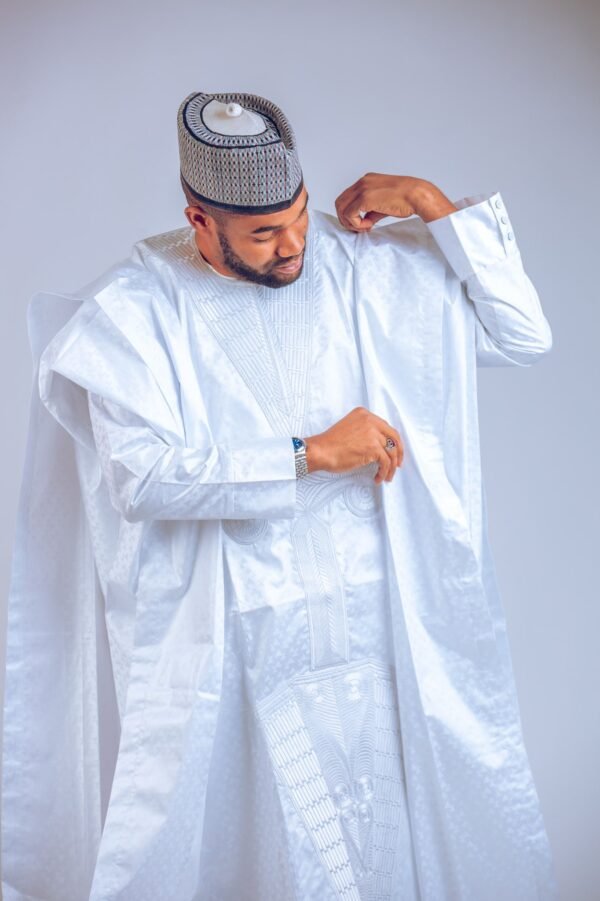
Hausa men’s clothing is characterized by its flowing, loose-fitting design, which ensures comfort in the region’s hot climate while maintaining an air of elegance and dignity.
Key Pieces:
- Babban Riga: A long, flowing robe often worn over a tunic and trousers. It is typically made from high-quality fabrics such as cotton or brocade and adorned with intricate embroidery around the neckline and chest.
- Jalabiya: A simpler, lighter garment, similar to the Babban Riga but less elaborate, often worn for daily activities or informal occasions.
- Hula: A traditional cap, usually made from handwoven or embroidered fabric. The Hula is an essential accessory that adds a finishing touch to Hausa men’s outfits.
Cultural Significance:
- The Babban Riga is often worn during special occasions, symbolizing status, respect, and cultural pride.
- The Hula showcases regional craftsmanship, with unique patterns representing different communities within Hausa society.
3. Traditional Hausa Attire for Women
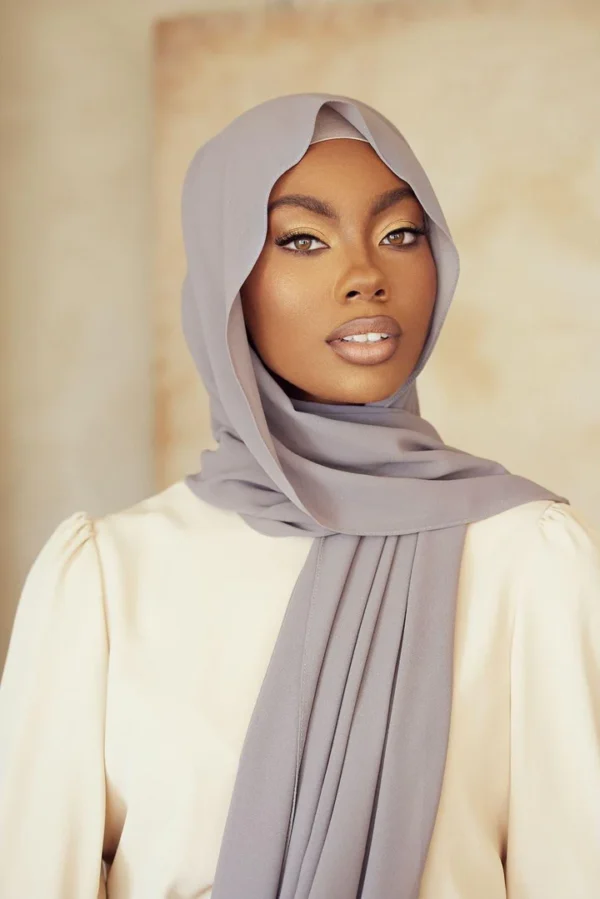
Hausa women’s fashion exudes grace and femininity, with garments that combine vibrant colors, modest designs, and exquisite details.
Key Pieces:
- Zani: A wrapper or skirt made from colorful, patterned fabric, often paired with a matching blouse.
- Buba: A loose-fitting blouse that complements the Zani. It is modest yet stylish, reflecting Islamic and cultural values.
- Hijab or Scarf: As a reflection of Islamic modesty, women often wear a hijab or headscarf, which is elegantly styled to match their attire.
- Kaftan and Ankara Gowns: Modern adaptations of traditional garments, these are increasingly popular for formal events, combining local aesthetics with contemporary designs.
Cultural Significance:
- The vibrant patterns and colors of Hausa women’s attire symbolize joy, prosperity, and creativity.
- Women’s clothing often showcases the handiwork of local artisans, particularly in embroidery and dyeing techniques.
4. Famous Hausa Fabric Craftsmanship
No talk of Hausa fashion is complete without mentioning the numerous native fabrics and craftsmanship that give style to their clothes. Such textiles are, in fact, examples of the expertise and genius of Hausa artisans.
Popular Techniques:
- Kofar Mata Dyeing Pits: These ancient dye pits, located in Kano, are famous for producing bright indigo-dyed fabrics, a trademark of Hausa style.
- Adire and Batik: Hand-dyed fabrics with intricate patterns used for wrappers, blouses, and other garments.
- Embroidery (Zare): The rich embroidery contributes to the expenditure on Hausa clothing; specifically, that of the Babban Riga is done with threads by hand.
Cultural Significance:
- The production of these fabrics is deeply rooted in Hausa tradition, with techniques passed down through generations.
- The textiles and patterns often carry symbolic meanings, representing social status, cultural identity, or personal expression.
5. Hausa Accessories: The Perfect Complement
Hausa fashion is enhanced by accessories that reflect the people’s attention to detail and love for craftsmanship.
Key Accessories:
- Leather Goods: Indeed, Hausa artisans are popularly known for their work in leather, making sandals, bags, and belts, among others. The famous Kano leather is a sought-after material.
- Jewelry: Women adorn themselves with gold, silver, and bead jewelry and are usually made up of very fancy designs and have cultural significance.
- Veils and Scarves: These are added accessories that give an extra touch of elegance and are usually embroidered or beaded.
Cultural Significance:
- Accessories often symbolize wealth, marital status, or cultural heritage.
- They demonstrate the Hausa people’s ability to merge practicality with artistic expression.
6. Modern Adaptations and Global Influence
Over the past two decades, the face of Hausa fashion has evolved to encompass a modern appeal from its core originality. Fashion designers from northern Nigeria and across the Hausa diaspora have managed to position Hausa-inspired clothes onto the international fashion scene.
Modern Trends:
- Fusion Designs: The fusion designs also make the modern Hausa outfit more applicable today to the global audience.
- Bridal Fashion: Hausa weddings are known for their pompous attire; brides wear very expensive gowns borrowed from their traditional clothes.
- Fashion Shows: Events like Arewa Fashion Week allow the Hausa to demonstrate how creative they can be regarding fashion innovation.
Global Influence:
- Hausa leather goods and fabrics have found international markets, showcasing the region’s craftsmanship to the world.
- The modest yet stylish nature of Hausa fashion has inspired global trends in modest clothing.
7. Cultural Significance of Hausa Fashion
Hausa fashion is more than just clothing—it is a cultural expression that communicates values, traditions, and social identity.
Key Themes:
- Modesty: Reflecting Islamic principles, Hausa fashion emphasizes elegance without compromising modesty.
- Cultural Pride: Traditional attire is worn with pride during festivals, weddings, and religious celebrations, showcasing the Hausa people’s connection to their heritage.
- Artistry: The intricate details and craftsmanship in Hausa fashion highlight the creativity and skill of its artisans.
8. The Role of Fashion in Community Life
Fashion is very important among Hausas; it is an essential medium through which they preserve their culture and communicate with people within their community. Fashion helps bond them together in times of jubilation and other events, and it bonds them together with a strong sense of identity.
Examples:
- During festivals like Sallah, people dress in their finest traditional attire, making a vibrant display of Hausa culture.
- Events such as weddings and naming ceremonies provide avenues to splash in elaborate designs and celebrate the ingenuity of local tailors and designers.
Conclusion
The traditional Hausa fashion culture is an interesting blend of tradition, skillful craftsmanship, and modern contributions. The Babban Riga is flowing with grace, while the Zani reveals bright colors and an intricate pattern; and the leather accessories add to the rich variety in Hausa fashion. Hausa fashion reflects a deep respect for tradition along with an openness toward contemporary influences. As Hausa designers continue to push the boundaries and showcase their work on the global stage, this unique fashion culture is a matter of pride and serves as a source of inspiration for future generations.


